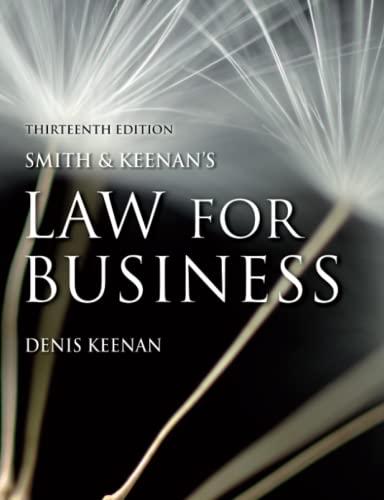Question
1. Look up Summary Judgment in the Nevada Rules of Civil Procedure, to familiarize yourself with this procedure, if you are not familiar with what
1. Look up Summary Judgment in the Nevada Rules of Civil Procedure, to familiarize yourself with this procedure, if you are not familiar with what it entails. It is usually a pre-trial motion in which both sides will usually ask the Court to summarily decide an issue or cause of action ahead of time because they feel it is so clear-cut, and the evidence overwhelmingly favors their side-- that there is "no genuine issue of material fact" for a judge or a jury to decide.
If the Court does grant Summary Judgment in whole or in part on a case, then that issue is off the table for trial. There is a "judgment" and therefore, a "verdict" on that issue. Both sides usually ask for this, either for the entire case, or for particular causes of action. It is gamesmanship. It is not usually granted, but it is a way to perhaps clear away some of the underbrush in a case and limit the issues that are before the Court at trial and score an early win, therefore, it is usually argued for in the name of "judicial economy" and not wasting the Court's time. (yesthe attorneys are only doing it to be considerate and do the Court a favor. Of course). When you are writing a Motion for Summary Judgment, it follows along the IRAC formula. The issue will be stated in terms of what the Plaintiff or Defendant is asking for and then in the Motion they will request that the Court grant Summary Judgment. The next section in the Motion (which is what you will be writing for this assignment) is a "Statement of the Law", which is basically what you are familiar with as the "Rule of Law" section in IRAC. Its purpose it to outline what the Court must consider in order to grant the Motion for Summary Judgment by citing case law. It is GENERIC. It contains nothing specific to the facts of the particular case before the Court. The value of having a Statement of Law for a Motion for Summary Judgment already written is that you can drop it into a pleading for any case. You will have a pre-written template. That is what this assignment is all about.
2. Review each case in the list and take a quote from each case that presents the Court's explanation of Summary Judgment and write the Statement of Law (Rule of Law) section for a Motion for Summary Judgment by putting information from each case together in a narrative form. This is not bullet points. You must take at least one (1) quote, but not more than two (2) quotes, from each case and use proper and correct citation form, including abbreviated citation form when appropriate. You must use every case. Some of the summary judgment material in each case will be more obvious that in others, but there is something you can use in each case, even if it is only a phrase. If you Google search each case by name you will find links to the case opinion.
You do not need to be concerned with the individual facts or holdings of these cases, nor should you use any part of the case that does not generally deal with Summary Judgment. Everything you need for this assignment is contained in the list of cases. Your task for this
assignment is to research "within" the cases---and craft a general explanation of the legal standard that must be met for the Court to issue an Order granting Summary Judgment, which could be used for any Motion for Summary Judgment, regardless of the specific facts of a case. It will basically be a very brief (one sentence) introductory explanation of what Summary Judgment is (referring to the Federal Rules of Civil Procedure) and when it is appropriate, followed by a collection of quotes, sentences or phrases, or paraphrasing the criteria taken from the cases. It is not a "list"it needs to flow in narrative fashion in the paragraph(s), so you need to use transitional language to connect the information you take from each case.
The entire assignment should not exceed one (1) page, double spaced. The heading for the assignment should look like this:
STATEMENT OF LAW A. Standard for Summary Judgment
LIST OF RULES and CASES for you to use: (NOTE: Since, for the most part, these are very lengthy cases, I have noted the particular pages that should give you the information you need). FRCP 56(e) Anderson v. Liberty Lobby, Inc., 477 U.S.242, 106 S.Ct. 2505 (1986). -- see pages 243, 248, and 255. Celotex Corp. v. Catrett, 477 U.S. 317, 106 S.Ct. 2548 (1986). --see pages 323-324 Matsushita Elec. Indus. Co., Ltd. v. Zenith Radio Corp. 475 U.S. 574, 106 S.Ct.1348 (1986). ---see pages 586-587 Richards v. Nielsen Freight Lines, 602 F.Supp. 1224 (E.D. Cal. 1985). ---see pages 1244-1245 Aydin Corp v. Loral Corp., 718 F.2d 897 (9th Cir. 1983). ---see pages 901-902
Step by Step Solution
There are 3 Steps involved in it
Step: 1

Get Instant Access to Expert-Tailored Solutions
See step-by-step solutions with expert insights and AI powered tools for academic success
Step: 2

Step: 3

Ace Your Homework with AI
Get the answers you need in no time with our AI-driven, step-by-step assistance
Get Started


